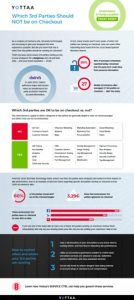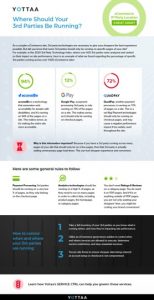In eCommerce, 3rd party technologies can mean the difference between shoppers having a great experience to leaving and never coming back. How? These 3rd parties have many jobs across your site, but the main one is to create the best shopping experience possible. From personalization, to ratings and reviews, to digital try-ons, to convenient payment plans at checkout. Shoppers need these features to feel comfortable making the purchase.
So, why is the location of where they are executing on your site important? As long as the ratings and reviews are on the product pages and the payment plan is on the checkout page, then why would there be any issues? Here’s the thing: Unless you have full visibility into where each and every 3rd party is running across your site, then you could be in trouble. Considering many brands aren’t even aware of all 3rd parties they have, it’s easy to believe that many cannot see where each one is executing.
Here are the main reasons why this knowledge is necessary to have for eCommerce brands, along with helpful tips on how to start taking control over your 3rd parties:
1. Security threats from 3rd party technologies
What do your ratings and reviews or social media 3rd party technologies have to do with security threats? They don’t handle shopper PII and therefore can’t cause any issues, right? Oh, so wrong.
The problem is, if you have any unnecessary 3rd party technologies running across your site, including your login and checkout pages, hackers can use these 3rd parties as an entryway to steal shopper data. We saw this first hand earlier this year with accessory brand Claire’s. In June 2020, Claire’s suffered a major data breach when an unauthorized 3rd party accessed customer account information.
And don’t think shoppers aren’t aware of the risk. In a recent report, 89% of surveyed consumers reported being concerned that 3rd party tech could steal their personal information. Another alarming statistic is that the same report found mobile eCommerce sites averaged 27 3rd parties on checkout — that’s WAY too many.
To help you understand and know what to do next, we’ve built an eCommerce 3rd Party Location Cheat Sheet for Checkout.
2. Performance issues from 3rd party technologies
The next area of your eCommerce site that can be affected by 3rd party location is your site performance and speed. While 3rd parties are necessary for shopper experience, they can actually make your site slower, deterring shoppers from making the purchase. While this has to do with more than just 3rd party location, knowing if there are unnecessary 3rd parties executing on each page is a great place to start.
What qualifies as “unnecessary”? If you have a 3rd party running across many pages of your site that should only be on a few pages, then that 3rd party is actually adding unnecessary page load times. This can hurt shopper experience. For example, you don’t need Ratings & Reviews on a category page. You do need it on PDP pages. And if it’s on anything outside of PDP pages, you are not only wasting your shoppers’ time, you might be costing your brand conversions.
To help you understand and know what to do next, we’ve built an eCommerce 3rd Party Location Cheat Sheet for Performance.
3. Take Control
The main reason eCommerce brands should know exactly where 3rd parties are running across the site is to gain control. With an eCommerce governance solution, you can control when and where all services are being executed, enabling you to knock out those security threats and help improve site performance and conversions.
Additional benefits of having full visibility into 3rd party location using an eCommerce governance solution include:
- Control when and where services are allowed to execute, determine service restrictions, and stop unwanted services.
- Block ads and unwanted coupon offers from external services so shoppers do not leave your site or receive unintended discounts.
- Help achieve CCPA/GDPR compliance.
- Secure site forms to ensure shopper data being entered at account setup or checkout is not compromised.
- Enable service-related alerts based on machine learning and AI.
Don’t become overwhelmed with the amount of 3rd parties on your site if you don’t already have full visibility and control into them. Yottaa can help!
We recommend getting started with a free eCommerce performance Snapshot Report to learn more about how your 3rd parties may be affected site performance.



